Foreign Insulators
by Marilyn Albers
Reprinted from "Crown Jewels of the Wire", April 1998, page 38
UNSOLVED MYSTERIES IN FOREIGN GLASS
Quite a bit has been learned about the various historical backgrounds of
foreign glass insulators, but several unique examples have left us scratching
our heads. What do the embossings (if any) tell us about the manufacturers? How
were the insulators used and where were they used? How many were made and when?
From what countries do they originate? Why have so few examples been found?
Presented here are nine glass insulators that we know little or nothing about.
Not all questions apply to all the insulators but if any of our readers can give
us additional information on even one of these, please contact your foreign
insulator editor (that's me) at the above address!
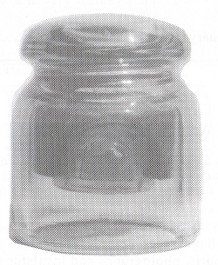
"CD 405 No Name"
CD 405 is what's known as a "Dry Spot" insulator (notice the upward
curved groove in the inner skirt). At this time there are only two examples
known to exist, neither of which is embossed. The glass color is a pretty yellow
green which looks very much like that of insulators produced by Verreries de
Folembray (Folembray Glassworks) in Aisne, Northern France, although it would be
unusual to find a Folembray product with no embossing. Just to complicate
matters, rumor has it that these particular specimens were found in Austria,
which is not too surprising because France exported many of her insulators to
countries in other parts of the world. Right now the 405 remains a mystery.
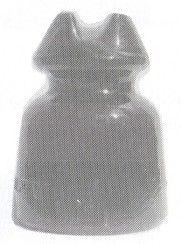
"CD 560"
CD 560 is embossed S.A.F.N.DE V // 92176, which stands for "Sociedad
Anonima Frabrica Nacional de Vidrio" or National Glass Factory, Inc.,
located near Montevideo, Uruguay. Strange as it may seem, "92176" is
the style number. The glass color of this insulator is a deep violet cobalt, one
of only three examples found to date, though a green one with no embossing at
all does exist in a collection. The odd thing about these insulators is that
there are vertical ribs in the pin hole instead of regular threads. At one time
all four examples were displayed in a cabinet owned by the British owned
Telephone company in Montevideo, but none were ever found in service. Were these
a type of experimental insulator made by the National Glass Company and just
never accepted? Will we ever know?
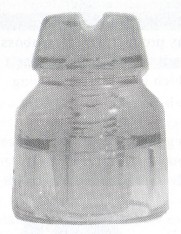
"CD 565.1"
CD 565.1 is embossed with the German name J. STOLLE ;, NIEMEN". This
insulator is made of aqua glass, it was found in Poland, and the style is quite
ordinary. To my knowledge this is the only one in captivity. Our foreign expert,
Miroslav Immer from Prague, Czech Republic, put forth a lot of effort to locate
a factory by that name in Europe but had no success. Perhaps one did exist some
time ago but was eventually taken over by another company that kept no records
of the merger. Or is it possible that the insulator was made by a Polish
manufacturer for a German user named J. Stolle Neimen?? We will keep digging!
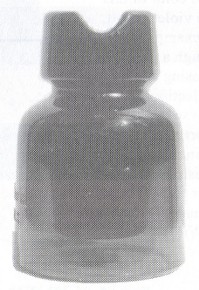
"CD 573"
The embossing on CD 573 is ISOFERM/R.M.2 and we know of only this one
example. It is made of dark green glass, the same color as the insulators made
by the French companies ISOREX and P.F.C. (Parvillee Freres & Cie). Marco
Schmitz-LeHanne of Krefeld, Germany, tells me that "R.M.2" stands for
"Reichs-Modell", which was the state model, or later after World War
II, "Regel-Model", the standard type. Both types have conductor
grooves on the crown (as opposed to those with round crowns) and were the first
petticoated insulators in Europe, which accounts for the fact that so many of
this style in both glass and porcelain were found in other countries. The
"2" indicates the size of the insulator. But what is
"ISOFERM"? Could this possibly have been the name of an ISOREX
subsidiary?
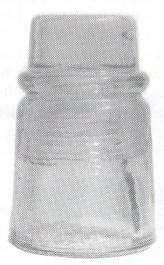
"CD 420.1"
CD 420.1 is unembossed. Four, and only four, of these were found on lines in
Australia a few years ago and were quickly traded among local collectors. The
color of glass is a light blue gray, which closely resembles that of some of
the CD 121 AGEE's. The feeling among Australian collectors is that the CD
420.1's were probably experimental pieces made by Australian Glass Manufacturers
(AGEE) in Sydney, N.S.W., but were never accepted for regular use. Those that
remain are now considered to be extremely rare. I have no reason to question
this information but still there is no proof. If Australian Glass Manufacturers
didn't produce the CD 420.1 's, then who did? Why were they unembossed? How many
were produced? Were they precursors of the CD 121 's?
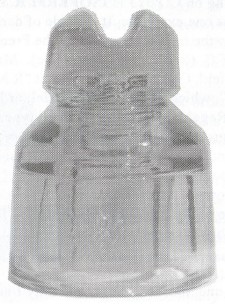
"CD 579.5"
CD 579.5 comes from Russia and is one of two examples known. It is a
beautiful insulator in rich lime green. Embossed in an arc on the skirt are the
Russian letters KA/\bIlOBCKOI, and in spite of the fact that I have my Russian
dictionary right in front of me I can't seem to make any sense out of them! Just
above the letters is a replica of the Russian Imperial Eagle. No one seems to
know anything about this insulator. How old is it? Was it made by a Russian
factory or somewhere else for use in Russia? What do the letters mean? Somehow I
believe there must be more of these because they have a modern appearance.
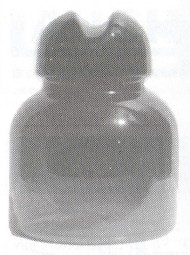
"CD 541"
CD 541 is still another mystery. A small number of these in clear and red
amber glass have been found on Finnish lines but with no embossing to give us
any clues, it is impossible to attribute them to any particular factory. These
three styles of glass insulators originated in Finland and include the CD 541,
CD 128, and CD 453. All three of them have triangular shaped pin holes. The CD
453 (and only the CD 453) is embossed KARHULA HEL-2. Karhula is the name of the
glassmaker but we don't know where in Finland it is located. HEL is for
Heikkovirta Eristin Lasi, or low voltage glass insulator, and the number 2
indicates both the size of the insulator and the thickness of the wire used.
Were the CD 128 and the CD 541 also made by KARHULA even though they are
unembossed? Is this company still in business? The insulators look as though
they were of fairly recent manufacture, but collectors who have traveled to
Finland have had no success in finding any more specimens, so they may not be so
common after all.
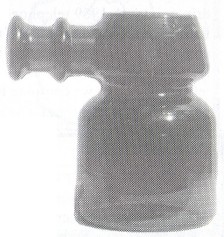
"CD 665"
We know of three glass styles with the "STAR" embossing. These
include a CD 563.5  , a CD 577.5 , a CD 577.5
 // 4, a CD 577.5 // 4, a CD 577.5
 // BT 4, and a CD 665 // BT 4, and a CD 665
 // T 3 (shown above). The CD 665 variation was found
in France but the other two types were discovered in Luxembourg, just to the
north of France. All three are of the same dark olive green glass, very much
like insulators made by ISOREX of France. Was the "STAR" trademark
indicative of the user or the manufacturer? Did the three trademark variations
come over time or were they used simultaneously? // T 3 (shown above). The CD 665 variation was found
in France but the other two types were discovered in Luxembourg, just to the
north of France. All three are of the same dark olive green glass, very much
like insulators made by ISOREX of France. Was the "STAR" trademark
indicative of the user or the manufacturer? Did the three trademark variations
come over time or were they used simultaneously?
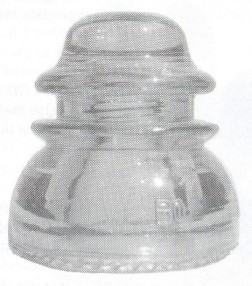
"CD 154"
This CD 154 is embossed VI-BO. So far these letters have not been attributed
to any manufacturer, but we do know that the insulator was discovered near
Bogota, Colombia S.A. several years ago by collector Caleb Thimell, now of
Portland, Oregon. VI-BO also appears on three examples of CD 106 that came from
the same source. To our knowledge, no others with this embossing have ever been
found. All four are made of olive green glass with standard American pin holes
and sharp drip points. A 1989 telephone book in Bogota included a listing for a
company called Vidrios Bogota, but Caleb was unable to find any connection
between that business and the insulators he recovered. Even though there are
many questions left unanswered, we continue to admire and treasure the glass on
our shelves!
| 